Editor’s Note: This is another part of a multi-part series looking at the new B-21 Raider stealth bomber by renowned expert Philip Handleman. You can find all parts of the series here.
While we don’t know exactly how much the B-21 will cost or how many will be built, then-U.S. Air Force acquisition chief William LaPlante in 2015 pegged the strategic bomber’s unit cost at $515 million in 2010 dollars, predicated on an aggregate buy of 100 bombers. Northrop Grumman prepared for a production rate of 15 a year, or an average of a little over one bomber per month, as a means to keep government budget-cutters at bay and production chugging along uninterrupted for a sustained period. If Northrop Grumman produces the new bombers at that rate, it would take just short of seven years to complete a total of 100.
The current officially cited unit cost for the B-21 is $692 million in 2022 dollars, a level the Air Force accepts as within “cost targets.” Northrop Grumman CEO Kathy Warden said during an earnings call that the bomber’s “unit cost projections remain below the government’s independent cost estimate.” The company even received a $66 million performance incentive payment as its engineering and manufacturing development phase wraps up.
However, the tone of Warden’s call implied uncertain financial sailing ahead for the program. Warden voiced concern about recent inflationary pressures, rising labor costs and supply-chain disruptions. The program is transitioning into low-rate initial production, known as LRIP, under a fixed-price contract covering the first of five lots. While Chief Financial Officer Dave Keffer said a loss on the LRIP output is not “probable,” he later acknowledged it is “possible” if the business climate deteriorates.
Warden used the call to editorialize on the unintended consequences of fixed-price contracts. She said that the current contractual construct works against the industry investing in “future capability and capacity.” With inflation still present, she averred that industry will push for renegotiated contracts as “just common sense,” adding that doing so “will become the norm.”
The Defense Department’s 2024 budget request allocates $5.3 billion for the B-21. Nearly $3 billion is for research, development, test and evaluation, and $2.3 billion goes to procurement, representing a year-over-year increase of about 40 percent in this latter account. While the B-21 is expected to enter the fleet about mid-decade, it would seem that unless procurement allocations increase even more steeply in the next few years, deliveries will stretch into the next decade, almost surely nudging up the unit cost due to inflation over time.
Still, unless the B-21’s unit cost jumps prodigiously from the currently quoted figure, the expenditure for each bomber will represent a big improvement over the B-2’s staggering unit cost of $933 million. The B-21 program has so far succeeded in preventing the runaway costs that plagued the B-2. This progress suggests that Northrop Grumman learned the lessons from the prior bomber’s development, which, in fairness, involved breaking new ground with work on the first large stealth platform.
Even Rep. Adam Smith, a sometimes vocal Pentagon critic and the ranking member of the House Armed Services Committee, was moved to praise the tight cost control on the B-21 program a couple years ago. However, in contrasting the costs of the B-2 and B-21, it should be kept in mind that only 21 of the first-generation stealth bombers were ordered, a fraction of the 132 that the Air Force had intended to buy.
Classic free-market theory holds that upping the quantity purchased will bring down the unit cost. By buying at least 100 B-21s, which is the minimum under consideration, the Air Force would help to keep the price tag in check, assuming no major technical problems or requirements changes going forward. Out of concern for the price risk that accompanies midstream changes in requirements, the B-21 program is structured so that only the Air Force chief of staff is empowered to order such changes.
Beyond price, there is the equally important matter of development tempo. In September 2019, a concept to keep fighter aircraft development animated and relevant was floated by Will Roper, then the Air Force acquisition chief. While focused on fighters, the underlying principle could have utility for vivifying the development of other aircraft types.
As first reported in Defense News, the Roper plan sought to mirror the development of the six so-called Century Series jet fighters, the F-100 Super Sabre through the F-106 Delta Dart, that were introduced from 1954 through 1959. Roper’s vision centered on what he referred to as the Digital Century Series, a batch of digitally designed, rapidly prototyped warplanes that would be rolled out every four or five years sporting newer off-the-shelf technologies, but not aimed at lasting a full generation – perhaps having an operational life-cycle of 6,000 flying hours rather than tens of thousands.
These planes would not be intended to represent quantum leaps in technology or even try to address the imagined threats of a generation ahead, but instead be geared to meet the threats lurking just beyond the horizon. Also, some of them might be designed as mission-specific platforms rather than attempting to be jacks-of-all-trades. Importantly, as conceived, the Digital Century Series would not replace the generational fighter, but rather complement it. If the design features of the generational fighter became stale with time, the ongoing Century Series program would, at least theoretically, have a relevant alternative for the near-to-intermediate need.
As critics have rightly pointed out, some of the Century Series platforms had dubious safety records and debatable results in their real-world applications. Given that the Cold War was underway, several of the fighters were designed to be interceptors protecting home shores — and in one case, a tactical nuclear weapon delivery platform. It is not hard to understand why these fighters did not exactly excel in the guerilla war of Vietnam.
It would be wrong, though, to rule out modern Century Series programs for various aircraft types because of how some of the 1950’s fighters fared. The point in reviving the development and procurement regimen of that period, whether for fighters or bombers, would be to replicate the organizing philosophy. After all, despite their faults, the original Century Series fighters offered design innovation, preservation of a vibrant aerospace industrial base, and advances in the state of the art that helped pave the way for future successful fighters.
The factors holding back the vision’s implementation include the harsh realities of limited funding and the consolidation of the country’s aerospace industrial base. To produce the Century Series fighters, the Air Force held design competitions, settling on North American Aviation, McDonnell, Convair, Lockheed and Republic. There simply aren’t that many major airframe contractors left standing. In fact, all but one of those grand names from the industry’s golden age are now gone, mostly absorbed into the few remaining giants.
The Air Force’s current acquisition chief, Andrew Hunter, used an appearance before the Air & Space Forces Association’s Warfare Symposium in Aurora, Colorado on March 7 to reveal that the Air Force has started to address the problem of anemic industry competition through an approach centered around the idea of “pooled vendors.” As reported by Air & Space Forces Magazine, it involves forming groups of contractors at the early stages of a program. Although only one will eventually be down-selected for that program, Hunter said that the Air Force “can select additional providers from the vendor pool over time.”
According to Maj. Gen. Steve Whitney, a Space Force acquisition official at the same event, his service is applying a similar technique that selects different providers to build a program’s satellites. As he phrased it, satellite contracts are “being given to multiple contractors.”
At this time, the country is reliant on just three aerospace defense contractors for most of its frontline crewed combat aircraft. Two of these, Lockheed Martin and Boeing, were partnered in the bomber competition that resulted in the B-21 contract award to Northrop Grumman.
A Digital Century Series and the pooled-vendor concept deserve their day in the sun. But in an era marked by grave threats to national security, can such acquisition reforms alone overcome the adverse impact of the aerospace industry’s consolidation? Increased and sustained government funding that matches the magnitude of the threats would add a greater measure of assurance that the country will obtain the arsenal it needs.
A revitalized aerospace industrial base would include a return to a rich mélange of centers of creativity. This would be akin to what the country had during World War II and the years immediately following, when more than a dozen iconic airframe manufacturers competed to fill orders for large numbers of military planes. Meanwhile, not all is bleak; there are encouraging signs.
Some contractors outside the Pentagon’s first tier of suppliers have won important combat aircraft contracts recently. Examples include L3Harris partnering with Air Tractor in a winning bid to supply the AT-802U Sky Warden to U.S. Special Operations Command for the armed overwatch mission, and Bell Textron’s successful bid to build its V-280 Valor tiltrotor for the Army’s Future Long-Range Assault Aircraft program. The former involved taking a tried-and-tested off-the-shelf design and modifying it for the mission, whereas the latter enhanced a fielded platform that had been years in development as a disruptive hybrid.

The B-21 Raider was unveiled to the public at a ceremony December 2, 2022 in
Palmdale, Calif. Designed to operate in tomorrow’s high-end threat environment, the B-21 will play a critical role in ensuring America’s enduring airpower capability. (U.S. Air Force photo)
Although entry barriers for defense startups can be daunting, there are instances where the effort is being attempted. Atlanta-based Hermeus has attracted venture capital investments and Air Force funding to develop and then fly a Mach-5 proof-of-concept demonstrator named Quarterhorse using its in-house Chimera combined-cycle engine. In November 2022, the engine achieved the critical turbojet-to-scramjet transition in a ground run at Notre Dame University’s Turbo-Machinery Laboratory.
Remarkably, the tiny startup reached the breakthrough static test in under two years on an $18 million budget. If the flying demonstrator proves successful, the young and enthusiastic team would build their Darkhorse uncrewed air system as a high-speed intelligence-surveillance-reconnaissance platform.
In specialty markets like drones, the entry barriers have not been as steep. Indeed, over the last couple decades privately owned General Atomics became a major player in the world of uncrewed aircraft. The San Diego-based company has produced the Predator/Reaper family of remotely-piloted air systems, which has become synonymous with the world of drones. Now the company is heralding its forthcoming Gambit series as the future of Autonomous Collaborative Platforms. The four envisaged Gambit types would share a common core but have different wing, tail and fuselage shapes optimized for specific missions, from stealthy reconnaissance to swarms.
Of course, the success of the U.S. aerospace industry is not preordained. Policies that incentivize the aerospace industrial base can help to preserve America’s aerospace preeminence. There is a need to expand surge capacity, recruit and retain talented and motivated individuals, and broaden the field of platform originators.

B-21 Raider
On Feb. 8, the heads of three of the largest aerospace and defense industry trade groups testified before Congress on a range of issues, including the problem of attracting and perpetuating a qualified workforce. David Norquist, a former deputy secretary of defense and president of the National Defense Industrial Association, recited jaw-dropping statistics: The defense industry employed 3 million workers in 1985, but by 2021 the number had dwindled to 1.1 million. To reverse the trend, he and the other industry leaders called for more predictability in government funding through the adoption of more multi-year contracts.

B-21 Raider. Image Credit: U.S. Air Force.
A glimmer of hope that workforce recruitment may be improving emerged during Northrop Grumman’s first earnings call of 2023. In answer to an analyst’s question about the challenging labor market, Kathy Warden commented that the company has drawn new talent in no small part because of the excitement surrounding last year’s B-21 unveiling — along with the deployment of the James Webb Space Telescope, the Hubble Space Telescope’s replacement and a Northrop Grumman product. Success begets success.
Author Biography and Expertise
Philip Handleman is a pilot and aviation author/photographer. With retired Air Force Lt. Col. Harry T. Stewart, Jr., he cowrote Soaring to Glory: A Tuskegee Airman’s Firsthand Account of World War II. Mr. Handleman’s photograph of the Air Force Thunderbirds was featured on the postage stamp honoring the 50th anniversary of the Department of the Air Force in 1997.

